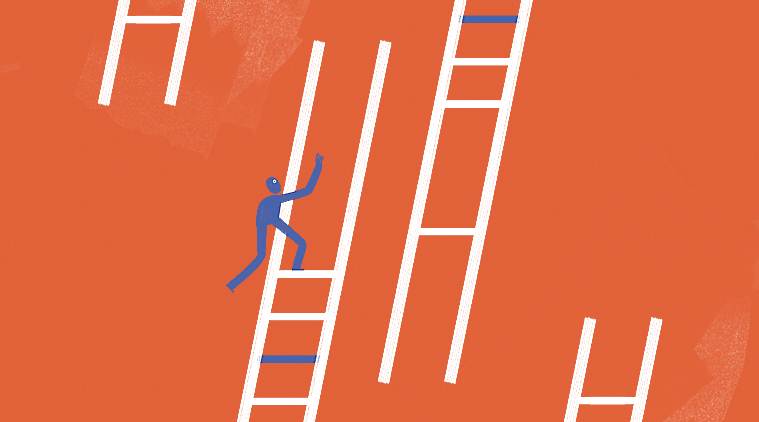Fissures amidst growth
In a milieu of impressive growth, India has developed some serious fractures that show no signs of cure.

(Illustration: CR sasikumar)
India is now among the fastest-growing large economies of the world. We clocked 7 per cent real GDP growth during October-December 2017; followed by 7.7 per cent in January-March 2018 and then 8 per cent in April to June 2018. Unless stung by some serious shocks, India should achieve an annual growth rate of around 7.5 per cent over the next few years.
The issue is not inadequate growth. Far more worrisome are some serious fractures that have emerged and show no signs of healing. We discuss four such: Female foeticide and infanticide; Failure of education; Rising inequalities; and Huge economic differences between regions of the country.
Female foeticide and infanticide: Some 120 km south-west of Delhi lies Mahendragarh, one of Haryana’s 22 districts. It has a disgraceful reason to feature here. With a sex ratio of 775 girls of 0-6 years for every 1,000 boys as per the 2011 Census, Mahendragarh is the nastiest district in India — in the worst state of the country — for female foeticide and infanticide.
Demographers agree that the “natural” sex ratio at birth for the world is 935 girls per 1,000 boys. Given the poor state of birth registrations in many parts of India, we use the sex ratio of girls per 1,000 boys between ages zero to six.
At 918 girls per 1,000 boys in 2011, India’s 0-6 sex ratio is among the poorest in the world. China’s is lower than ours. Worse still, it has been steadily declining between 1961 and 2011. With an outrageously low sex ratio of 834 girls per 1,000 boys, Haryana is the vilest state, with every district faring poorer than the poor all-India average.
Haryana isn’t the only disgrace. In 2011, the 0-6 sex ratio in Punjab was 846, or 7.8 per cent below the all-India average, with all its districts faring poorer than India. Twenty-eight of the 33 districts of Rajasthan were worse than India, as were 47 of the 71 districts of Uttar Pradesh (UP). Baghpat, just 31 km from Delhi, was at the bottom with 841 girls per 1,000 boys; Gautam Buddha Nagar, just beyond Greater Noida, was 840; Ghaziabad was 850.
In 17 of the 26 districts of Gujarat, the 0-6 sex ratios were poorer than India’s. Surat, one of the country’s richest districts, had a ratio of 835 girls per 1,000 boys, ranking among the bottom 25. Ahmedabad had 857 girls per 1,000 boys, or 7 per cent lower than all-India. In Gandhinagar, the capital, the ratio was 847, or 45th from the bottom. In Maharashtra, for 22 of 35 census districts, the ratio was poorer than India’s.
Simply put, much of north India, western UP, Rajasthan, Gujarat, Maharashtra and the northern part of Madhya Pradesh rampantly engage in ultrasonography to detect and then illegally abort female foetuses. The saving grace is that eastern, north-eastern and southern India do not. Despite tough laws against sex-determination and female foeticide, there is no police action to speak of. For instance, during 2001-2015, Haryana registered only 139 police cases — in a state which is unparalleled in this crime. We rampantly kill female foetuses. With impunity.
Failure of education: In a rapidly digitising world, India is wholly unequipped to supply quality education. According to the 2011 Census, 14 per cent of men aged 25-34 years hadn’t studied beyond class 10, 11.5 per cent hadn’t progressed beyond Class 12 and only 14.6 per cent were graduates. For women, these numbers were poorer: 10 per cent stopped studying after class 10, 8 per cent after class 12 and just 11 per cent were graduates.
According to the Annual Status of Education Report for 2017, 25 per cent of rural students of 14-18 years could not read basic text fluently in their own language. Over 50 per cent struggled with dividing three-digits by one-digit. In a ruler and key experiment, 60 per cent couldn’t calculate the length of a key if placed away from the “0” mark on the ruler. Half the students could not answer this question: “If you need three tablets to purify 15 litres of water, how many will you need to purify 35 litres?” These are going to be the sentinels — the demographic dividend — of our globalised knowledge economy.
Rise in inequalities: Though there are over 240 million desperately poor people in the country, poverty has clearly reduced in both rural and urban India. Not so inequalities. We don’t have good estimates of either wealth or income inequality, but we do of household consumption expenditure, thanks to large samples used in the quinquennial rounds of the National Sample Survey. Based on these, we can calculate the Gini coefficient — which ranges from 0 and 1, with a higher Gini implying greater inequality.
In 1993-94, the Gini coefficient for India as a whole was 0.301. By 2011-12, it had risen to 0.359. Not surprising, urban India has shown greater increases in inequality. The urban Gini for 1993-94 was 0.319, which increased to 0.377 in 2011-12.
From a cross-country perspective, we still don’t have frighteningly large inequalities in consumption expenditure or income, such as in Brazil, Mexico, Malaysia, South Africa and, nearer home, Pakistan. However, wealth inequalities are becoming obviously large. Juxtapose the image of Antilla off Peddar Road with the slums of Mumbai and you will know what we mean. In a country where everyone has a voice, the worse off are seeing too many signs of excess wealth and “in-your-face” consumption. Over 2.5 million people died of starvation in the Bengal famine of 1943 without any large-scale riots or killings. Don’t expect such other-worldly quiescence when people start taking to the streets against inequalities.
Districts being left behind: The 2001 and 2011 censuses have a series which lists household ownership and access to some basic assets and amenities. These are: Pucca house, electricity, latrine, separate bathroom, bank account, television, phone, two-wheeler and LPG connection. Based on these, one can construct a ranking of each district of India, from the “richest” to the “poorest”. What do we see?
The north (Punjab, Himachal Pradesh, Uttarakhand, Western UP), the irrigated parts of Rajasthan, most of Gujarat, parts of Maharashtra, Goa, parts of Karnataka, most of Andhra Pradesh and Telangana, all of Kerala and much of Tamil Nadu do well.
The districts that fare poorly cover most of Bihar, Jharkhand, Chhattisgarh, central and eastern Madhya Pradesh, Orissa, parts of West Bengal, lower Assam, parts of upper North East and the tribal belts of Gujarat and Madhya Pradesh. If you drew a longitude somewhere between Allahabad and Varanasi you could say this: West of the line is the zone of relative prosperity; east of it lie the districts of absolute and relative misery.
These are some of our fractures that we should fear. And so fearing, work on fixing them. But who are we to expect such action from our leaders?
The writers, both from CERG India Private Limited, work on large data sets and are writing a book on these and other fractures.
For all the latest Opinion News, download Indian Express App
More From Omkar Goswami
- Taking stock at 71We have not made sufficient investments for a fair, just and humane society..
- So, how did they ponzi it?How did Nirav Modi, Mehul Choksi and some rogue bankers take PNB for the mother of all rides?..
- The Big Bong TheoryAn effective, humourous account of the history and idiosyncrasies of the Bengali community — from one of their own...







































No hay comentarios:
Publicar un comentario